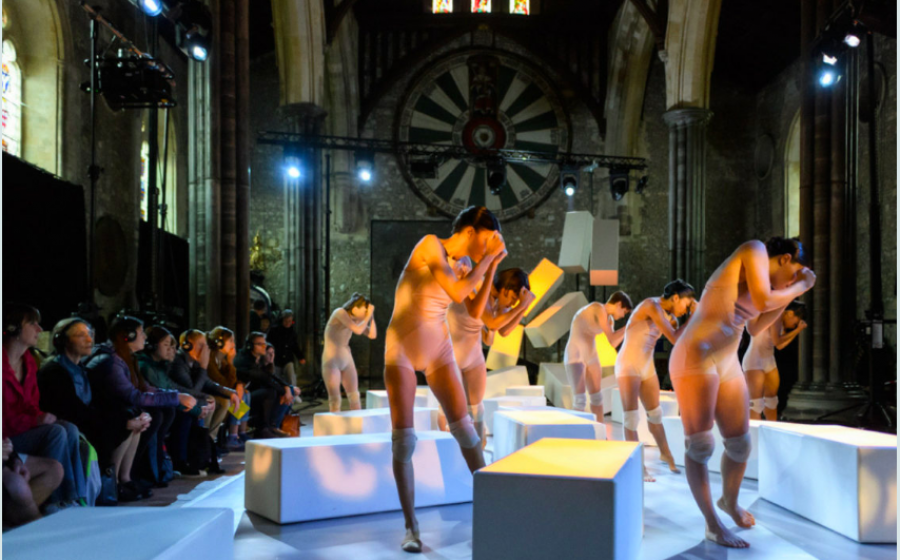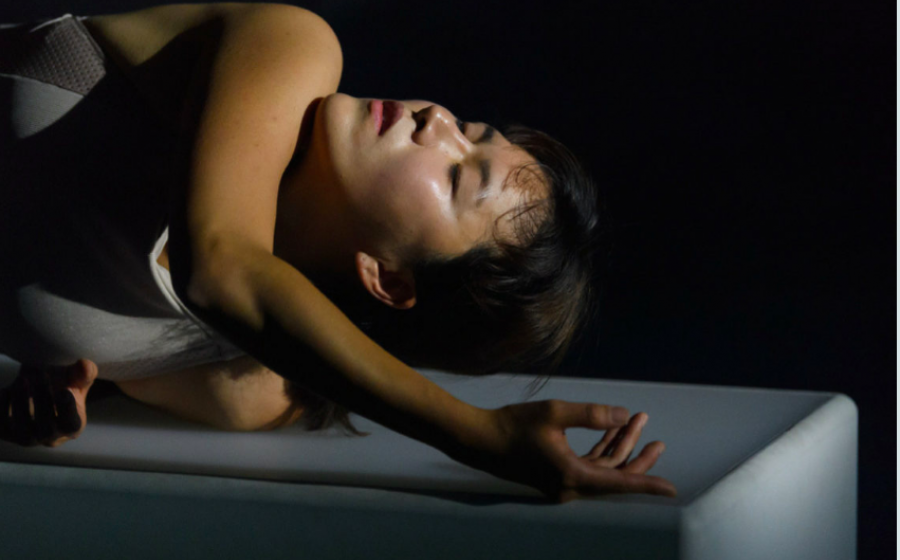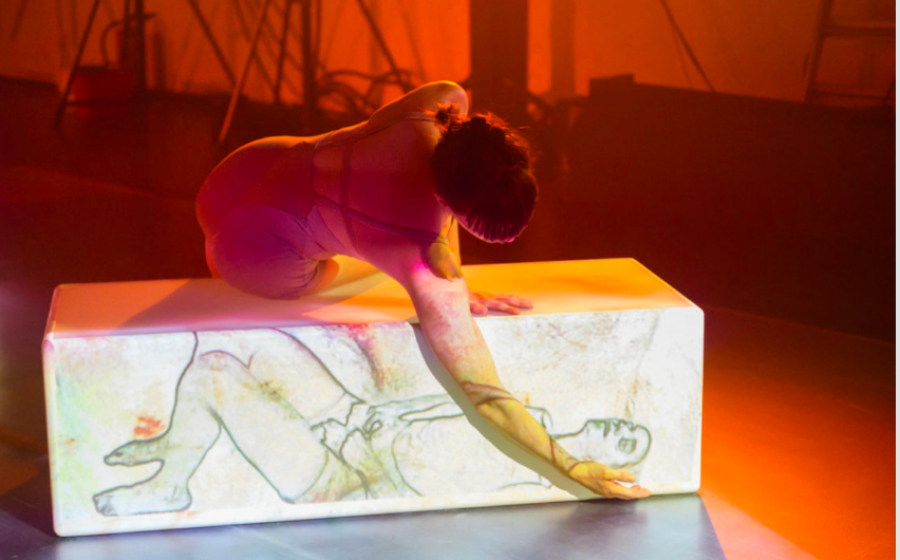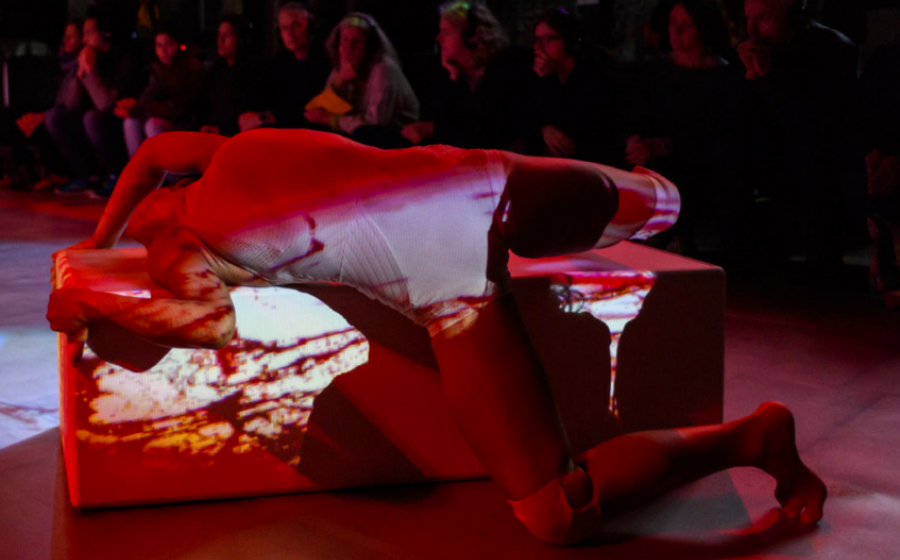Contagion
Contagion
A dance installation inspired by the Spanish Flu
Shobana Jeyasingh Dance
British Library, London
3 November 2018
Reviewed by the Pulse Dance Club.
We bring together here the responses of eleven individuals who saw the piece together on Saturday and discussed it afterwards.
Contagion has been produced as part of 14-18 NOW, the UK’s national arts programme for the First World War, of which a guiding objective has been to bring new perspectives to stories around the war. The 1918 flu pandemic killed more than twice as many people as the war itself, perhaps as many as 100 million around the world. Contagion brings our attention to the virus that came through the air, transmitted from birds to humans, so that while bombs were attacking from without, bodies were being attacked from within. The sound of bomb-blasts gives way to the screech of birds, with a Hitchcock–like sense of horror. Plummeting birds become the onslaught of the virus.
Eight dancers play out the narrative, the movement meticulously integrated with digital visuals, soundscape, voice-overs from personal and medical records setting scenes in India and in Lowland Scots accents; with exquisite changes of light, on the bodies of the dancers and on blocks scattered around the floor and cascading down like a tsunami. These blocks are sick-beds and mortuary slabs, the site both of the agony of the illness and of the tenderness and helplessness of those nursing the victims. The piece makes great demands of the dancers, both in terms of physicality and expressiveness, and as the piece progresses we see that they are fully invested in every moment.
Contagion is Jeyasingh's most emotionally affecting piece of dance theatre to date, perhaps because of the theme of devastation and death which elicits a visceral response from the choreographer. The immaculate research by the dance maker ensures a piece which holds together in every aspect: the text, the visuals and sound score. The seemingly innocent nursery rhyme ‘I had a little bird' is chilling as the birds were the carrier of the virus. ‘I opened the window and in-flew-enza’. The projections on the body of red and purple blotches spreading like ink on a blotter are both gory and fascinating in their intricacy.
The headphones issued to each member of the audience (possibly because of variable acoustics in the different venues) made the experience for some intense and personal, creating a feeling of intimacy in a large space, and producing the extraordinary effect of dancers apparently dancing in silence. However, some felt that wearing the headphones disconnected them from the dance.
The ensemble of dancers are like a Greek chorus in the opening section: in unison they hold postures of supplication, of the wailing of mourners, of holding and supporting the grieving, never translating word for word but rather the emotional heft, as the voiceover speaks the words of a young man in India who has been called home because his new wife is gravely ill; the Ganges is filled with bodies and his family, down to a nursing baby, dies one by one,. The story of how a whole village is wiped out is delicately handled, with the intelligence of the dance maker bringing to life a simple story line, with dancers in simple costumes – with suggestion of bandages – that allow the focus on the body.
The body literally becomes the battleground as the virus takes hold, the dancers writhe, lash, grasp. The choreographer responds with both graphic illustrations of the effect of the virus such as gasping for breath, the distortion of the face and the mouth, the compulsive twitching – there is great scope for movement. The sections with the dancers lying with head hanging being pushed off the plinth to make room for the next person suggests the seemingly endless turnaround of patients and the sheer numbers affected.
The journey of the piece is punctuated by changes of energy: Jeyasingh's affinity for dynamic and strong physicality is expressed in the abstracted partner work of exquisite beauty; there are deft contrasts, with moments of rest and silence; precision and tenderness; once again thrashing and compulsive twitching as limbs are thrown asunder; simple and powerful gestures.
The inter-actions between the projections and the dancer movements reach a pinnacle of perfection as the cradling of the head in the flesh and blood of the dancer holds the head of the figure projected on the side panel of the plinth: or a magic moment when the live hand covers the projected hand. The style of the projected figures, as well as some of the movement shapes, are a reference to the work of Egon Schiele, the Austrian artist who was killed by the flu in 1918. Some of the group in discussion commented on the apparently sexual connotations of spread legs – this may allude to Schiele’s work, at the same time as representing the body that has no control over how it moves when it is wracked by a disease. Some spoke of intertextuality, and saw references also to Leonardo drawings and Rodin.
Some felt that with so much death, there was room in the work for the faith or belief that many must have searched for or relied on in such a time of devastation and loss – though others responded that compassion was present in the tender nursing and caring that was portrayed. It’s possible that the immaculate virtuosity of the piece left one detached, rather than emotionally engaged, by what one saw and heard.
It feels this presentation is almost a new medium in which dance is so closely enmeshed with visual design and projection that it becomes an art form that sits between dance and visual art, belonging even more to galleries than to a theatre space.
All in all Contagion is an artwork of great visual beauty and emotional impact which teaches us about a devastating event in human history. It resonates a hundred years on with continuing wars and diseases (Syria, Yemen, the Ebola virus) and remains with the viewer afterwards, perhaps in dreams or even nightmares. The disturbing irony is that one can create a piece of such arresting beauty from such a deadly event.























